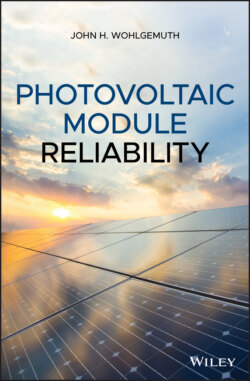Читать книгу Photovoltaic Module Reliability - John H. Wohlgemuth - Страница 10
1 Introduction
ОглавлениеPhotovoltaics (PVs) is the direct conversion of light into electricity. Typically, this means generation of electricity from sunlight, a renewable energy process without release of pollution or greenhouse gases. PV is one of the renewable energy sources that offers the potential to replace burning of fossil fuels and, therefore, to slow the growing effects of global climate change.
When the author began working in PV at Solarex in 1976, the entire worldwide annual production of PV modules was less than 100 kW. Numerous groups [1, 2] are predicting that more than 100 GW of PV modules will be produced and shipped in 2019. That is a growth in production volume of more than six orders of magnitude across a span of little more than 40 years. PV has gone from a small niche business, providing electricity for remote power applications to a mainstream, electric power producing industry. It has been estimated that PV provided approximately 3% of the world's electricity in 2018. PV and wind have been the two fastest growing sectors in commercial electricity production in the world for a number of years [3].
So why has PV been so successful? Certainly, the fact that PV is a clean, non‐polluting source of electricity is very important. The fact that the prices for PV modules have fallen dramatically from more than $40 per peak watt in the 1970s to around $0.40 per peak watt today [4] has also certainly helped. Today's price level makes PV one of the lowest‐cost sources of electricity in the world. However, none of these would really matter if PV technology, in general and PV modules in particular, were not very reliable and have long service lives. How many products do you know of that have to work outdoors in all kinds of weather and yet are provided with a 25‐year warranty? Since PV is a solid‐state process, there are no moving parts and very little to wear out so PV modules should be able to operate for a long time. Longevity is critical to the value of PV since the investment to install a PV system is made in the beginning and then the income accumulates over years as the electricity is sold. Without reliable PV products, no one would be risking billions of dollars to purchase and install the PV power systems that have made PV the success it is today.
This book is about Photovoltaic Module Reliability. Modules are usually the most reliable component within a PV system, but it is important to continue to study their reliability. Modules are the most expensive and by far the hardest to replace component in the PV system if something goes wrong. Any large‐scale failure of modules could result in dramatic reductions in growth of the PV power industry. This book has been written from a historical prospective to help the reader understand how PV modules were able to achieve 25‐year lifetimes and a well‐deserved reputation for reliability. Knowing how this level of reliability was achieved, can help in understanding how to maintain similar reliability in the future with new generations of products.
This introductory Chapter will provide some background for the in‐depth look into module reliability in subsequent chapters. The first section provides a brief history of PV. The second section discusses some of the different types of materials and devices used for commercial solar cells. The third section covers module packaging, including their purpose; the types of structures used for different modules, and a brief introduction to the types of materials used in today's commercial PV modules. The next section discusses what the author means by the reliability of PV modules as well as introducing several other terms that will be used throughout the book. The final section in this first chapter provides a brief overview of what is contained in each of the subsequent chapters.
